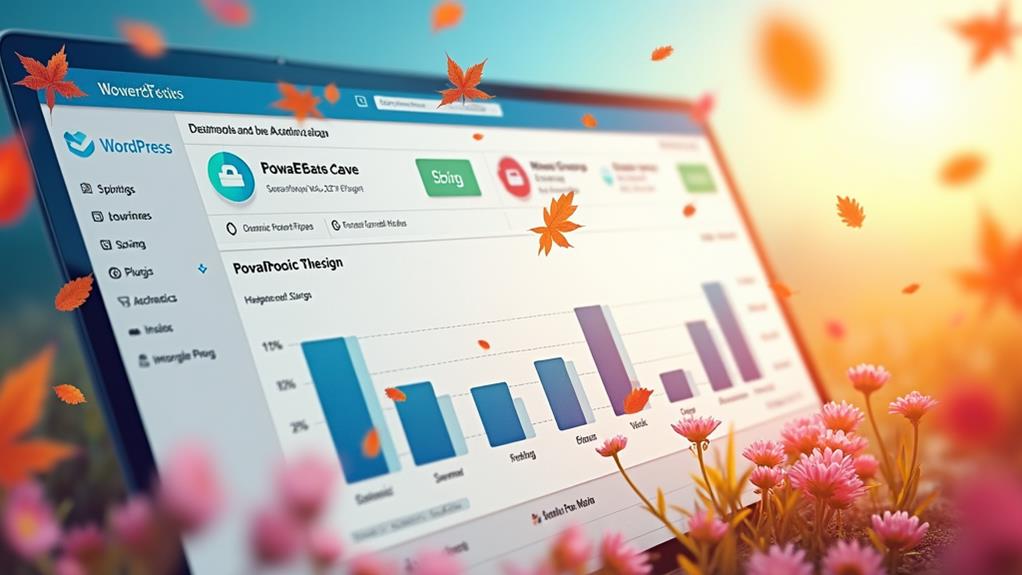For effectively scheduling and publishing seasonal content, robust tools like Sprout Social, Later, and Tailwind offer essential capabilities. Sprout Social uses engagement data to optimize posting times, boosting visibility by up to 60%. Later provides a visual calendar for cohesive branding, while Tailwind's SmartSchedule suggests peak posting times based on audience metrics. Key features to prioritize include automated posting, analytics, multi-platform support, and collaboration tools to enhance strategy alignment and streamline workflows. Using these insights can drive engagement and guarantee content strategies align with audience trends and seasonal timelines. Explore further to maximize your seasonal content's potential.
Key Takeaways
- Sprout Social optimizes posting times with engagement data, enhancing content visibility and reach by up to 60%.
- Later provides a visual content calendar for cohesive branding and effective seasonal campaign planning.
- Tailwind's SmartSchedule suggests optimal posting times based on audience engagement metrics for successful seasonal content delivery.
- Zoho Social's SmartQ identifies peak engagement times, ensuring timely delivery of seasonal posts for maximum impact.
- SmarterQueue automates reposting of evergreen content, maintaining consistent engagement during peak seasonal periods.
Top Tools for Seasonal Scheduling
As marketers gear up for the seasonal surge, leveraging the right scheduling tools can make all the difference in maximizing content impact. Understanding seasonal trends and aligning them with audience behavior is essential for enhancing engagement.
Among the top tools, Sprout Social stands out by offering excellent scheduling features that analyze past engagement data. This insight-driven approach allows marketers to post at the most advantageous times, enhancing visibility and reach by up to 60%.
Later's visual content calendar is another powerful tool that aids in planning and previewing seasonal posts. This guarantees that branding and messaging remain cohesive throughout the festive period, catering to audience preferences effectively.
Similarly, Tailwind's SmartSchedule functionality suggests the most effective posting times, based on audience engagement metrics, thereby enhancing reach and interaction.
Zoho Social's SmartQ feature further enhances scheduling precision by identifying peak engagement times, guaranteeing timely delivery of seasonal content to maximize audience impact.
Finally, SmarterQueue automates the reposting of evergreen content during peak seasonal periods, maintaining consistent engagement without requiring constant manual updates.
Each tool offers unique capabilities that cater to the dynamic nature of seasonal trends and audience behavior, guaranteeing strategic content delivery.
Features to Look For
When selecting scheduling tools for publishing seasonal content, content managers should prioritize key features that streamline campaign execution and enhance strategic alignment with audience preferences.
A robust content calendar is essential for visualizing and managing seasonal campaigns effectively. This feature facilitates timely content delivery aligned with key dates and events, guaranteeing that content resonates with audience expectations and trends.
Additionally, automated posting capabilities are critical, allowing for bulk scheduling that considerably reduces manual effort during busy seasonal periods.
To maximize the impact of seasonal content, tools that offer analytics and insights are invaluable. These features enable content managers to track performance and make data-driven adjustments, optimizing future campaigns.
Collaboration features also play a pivotal role, allowing teams to coordinate seamlessly on content creation and approval processes, thereby improving efficiency and coherence in messaging.
For a holistic approach, selecting tools that support multiple social media platforms is essential. This functionality guarantees a unified marketing strategy across various channels, enhancing reach and engagement.
Key features to look for include:
- Robust content calendar for effective campaign visualization
- Automated posting for efficient bulk scheduling
- Analytics for performance tracking and data-driven adjustments
- Collaboration tools for seamless team coordination
- Support for multiple social media platforms for unified marketing
Streamlining Content Creation
Enhance your seasonal content creation by leveraging intuitive planning tools that simplify collaboration and foster innovation within your team.
These tools offer a structured environment for content brainstorming, allowing teams to generate and refine ideas efficiently. By centralizing your content planning process, these platforms guarantee every team member is aligned on seasonal themes, facilitating a cohesive creative strategy that resonates with your audience.
Furthermore, the use of such tools enables a streamlined workflow, minimizing bottlenecks and enhancing productivity. With everyone on the same page regarding timelines and responsibilities, content production becomes more agile and responsive to market demands.
This alignment is vital in the fast-paced world of seasonal marketing, where timely execution can dramatically influence engagement rates.
Incorporating data-driven insights, intuitive planning tools provide valuable feedback on content performance. Regularly reviewing this data allows teams to adjust their strategies, guaranteeing content remains relevant and impactful throughout the season.
By continuously refining your approach based on performance metrics, your team can maintain a competitive edge, effectively harnessing seasonal themes to capture audience interest and drive engagement.
Ultimately, these tools are indispensable for teams aiming to optimize their seasonal content strategy.
Optimizing Posting Times
Building on the foundation of streamlined content creation, enhancing posting times can further amplify your seasonal content's impact. By harnessing audience analytics, brands can pinpoint engagement patterns and schedule posts to reach their audience when they are most active.
Scheduling tools are essential in this process, as they analyze 16 weeks of posting data to identify the best send times, potentially boosting reach by up to 60%. This data-driven approach allows brands to tailor their strategies, guaranteeing that their messages resonate with the intended demographics during peak periods.
Advanced scheduling tools offer automated suggestions for ideal posting times, making it easier for brands to execute their seasonal campaigns effectively. By aligning posting schedules with audience behavior, businesses can enhance impression generation and foster greater interaction with their content.
Regularly reviewing performance metrics is vital to refining these strategies over time.
Consider these key points for enhancing posting times:
- Utilize audience analytics to uncover peak engagement patterns.
- Leverage tools that analyze past data to suggest ideal times.
- Adjust posting schedules based on specific demographic insights.
- Regularly review performance metrics to refine strategies.
- Automate posting schedules to guarantee consistent delivery.
Embracing these practices can maximize the visibility and impact of seasonal content.
Boosting Engagement With Insights
Releasing the potential of your seasonal content hinges on leveraging data-driven insights to craft posting strategies that resonate with your audience.
By analyzing engagement data over a 16-week period, marketers can pinpoint ideal timing techniques that greatly enhance reach and interaction.
Utilizing these insights not only refines content delivery but also guarantees your brand remains agile, adapting to emerging trends and audience preferences with precision.
Data-Driven Posting Strategies
Leveraging historical data to inform posting strategies is pivotal in amplifying audience engagement and maximizing content reach. Audience analysis and performance metrics serve as the backbone for crafting effective content schedules.
By tapping into 16 weeks of historical data, marketers can align their posts with peak audience activity, leading to a potential 60% boost in reach and engagement. Understanding these insights allows brands to tailor their posting times, enhancing both impressions and interaction rates.
Data-driven insights offer a robust framework for refining content strategies. By employing advanced data analysis tools, brands can pinpoint which posts resonate most effectively with their audiences. This not only optimizes current campaigns but also lays the foundation for better seasonal content planning.
Scheduling tools equipped with analytics capabilities enable teams to track the performance of seasonal content meticulously, drawing from successful engagement trends to inform future campaigns.
- Audience Analysis: Identifying target demographics and behavior.
- Performance Metrics: Measuring the success of content strategies.
- Optimal Send Times: Aligning posts with peak activity for engagement.
- Content Visibility: Enhancing reach by understanding audience patterns.
- Seasonal Planning: Utilizing insights for timely, relevant content.
Optimal Timing Techniques
Effective timing is a cornerstone of successful content engagement strategies, and understanding ideal timing techniques can greatly enhance audience interaction.
Leveraging tools that offer Ideal Send Times is vital for brands aiming to maximize their reach by up to 60%. These tools utilize audience analysis, examining up to 16 weeks of engagement data to pinpoint the best times for content delivery. By aligning content timing with when audiences are most active, brands can markedly boost their interaction rates.
Scheduling tools provide invaluable insights into peak engagement periods. For instance, data-driven strategies can reveal seasonal trends, offering brands the opportunity to tailor their content around specific events or holidays. This not only enhances impression generation but also guarantees that the content resonates more deeply with audiences during these times.
Regular performance metric reviews of past posts are essential for refining future scheduling decisions. By understanding previous successes and failures, brands can continue to publish content at ideal times, maintaining consistent audience engagement.
Ultimately, these insights help brands to not just meet but exceed audience expectations, keeping content timely and relevant in an ever-evolving digital landscape. This strategic approach to content timing is key to sustained engagement and brand loyalty.
Enhancing Team Collaboration
In today's fast-paced digital landscape, efficient team collaboration is paramount for executing successful seasonal content strategies.
Scheduling tools equipped with streamlined content coordination, real-time collaborative editing, and centralized asset management empower teams to work more cohesively, ensuring timely and consistent messaging across platforms.
Streamlined Content Coordination
Centralized content calendars revolutionize the way teams coordinate and collaborate on seasonal content planning. By providing a unified platform, these tools enhance content alignment and guarantee that all seasonal themes are cohesively integrated across various channels. This is vital for maintaining a consistent brand voice and maximizing the impact of seasonal campaigns.
The ability to seamlessly share and communicate within a centralized system empowers teams to efficiently allocate resources and responsibilities, thereby streamlining the entire content coordination process.
Key features of these advanced scheduling tools include:
- Message Approval Workflows: By incorporating structured approval processes, teams can guarantee all seasonal content meets brand standards before going live, markedly reducing the risk of errors.
- Calendar Notes: These allow teams to document discussions and track the progress of seasonal campaigns, ensuring everyone is on the same page.
- Integration with Asset Management: Direct access to a repository of seasonal content assets simplifies production and sharing, enhancing overall efficiency.
- Enhanced Communication Tools: Features that support seamless inter-team communication prevent misalignment and improve coordination.
- Cross-functional Collaboration: The ability to bring together diverse stakeholders facilitates a more holistic approach to content planning and execution.
Real-time Collaborative Editing
Amidst the fast-paced demands of seasonal content publication, real-time collaborative editing emerges as an essential feature for enhancing team collaboration and efficiency. This capability empowers multiple team members to work on content simultaneously, considerably improving editing efficiency and minimizing the time required for revisions.
Scheduling tools like Sprout Social and Loomly integrate sophisticated collaborative features, such as comment and feedback systems, which facilitate seamless communication throughout the content creation process.
These platforms offer more than just basic collaboration; they provide structured workflows that guarantee quality control and adherence to brand standards. For instance, Sendible includes message approval processes that allow all team members to contribute effectively while maintaining oversight. This assures that the final content aligns with the brand's voice and objectives, vital for impactful seasonal campaigns.
Moreover, the inclusion of version history tracking in these tools allows teams to review and manage changes during collaborative editing. This feature guarantees transparency and alignment, allowing teams to verify that everyone is on the same page before content is published.
Efficient Asset Management
As teams embrace real-time collaborative editing to streamline content creation, the need for efficient asset management becomes increasingly apparent. Centralized asset management tools have emerged as a pivotal solution, enabling seamless content organization and workflow automation.
By housing all assets in a single, accessible location, these tools greatly enhance collaboration efficiency, allowing team members to focus on creativity and strategy.
In today's fast-paced digital landscape, maintaining brand standards and meeting deadlines are paramount. Efficient asset management tools support these goals by incorporating message approval workflows, ensuring that every piece of content adheres to brand guidelines before publication.
Additionally, content calendar sharing and integrated calendar notes simplify cross-departmental communication, aligning efforts and strategies with ease.
To optimize your team's collaborative efforts, consider the following benefits of efficient asset management:
- Centralized Access: All assets are available in one location, eliminating the chaos of scattered files.
- Real-Time Updates: Instant access to the latest versions of assets keeps everyone on the same page.
- Structured Reviews: Approval workflows automate feedback and maintain content quality.
- Enhanced Communication: Shared content calendars streamline coordination among stakeholders.
- Strategic Documentation: Calendar notes capture and organize team insights and feedback efficiently.
Integrating Social Media Platforms
Integrating social media platforms into scheduling tools is a strategic move that allows businesses to enhance their content distribution strategy by enabling seamless cross-posting.
Social media integration facilitates cross platform management, allowing companies to efficiently manage and publish seasonal content across multiple channels from a single interface. This integration is not only about convenience; it maximizes reach and engagement by ensuring content goes live at ideal times based on audience analytics.
Tools like Sprout Social and Later provide centralized dashboards that simplify the scheduling process. These platforms offer analytics and insights, allowing marketers to schedule posts when their audience is most active, ensuring the highest potential engagement.
Tailwind and Zoho Social further enhance campaign planning with features like SmartQ, which identifies peak engagement times specific to each platform.
Additionally, the automation capabilities of these tools greatly reduce manual efforts. By automating the posting and monitoring of seasonal content, businesses can maintain consistent messaging across diverse social channels.
This consistency is vital for maintaining brand identity and enhancing audience recognition. With real-time analytics, marketers can track performance, making data-driven adjustments to refine their strategies, ensuring that seasonal campaigns achieve their desired impact.
Evaluating Pricing and Plans
While selecting the right scheduling tools for seasonal content, understanding the pricing and plans offered by these platforms becomes a significant factor for businesses. Engaging in a competitive analysis enables companies to align their choices with budgetary constraints while ensuring ideal features for their needs.
Pricing transparency is essential, as evidenced by platforms like Brandwatch, which opts for a request-based pricing model aimed at mid to large-sized businesses. This approach can limit immediate decision-making but offers tailored solutions.
Meanwhile, Sprout Social provides clear tiered pricing from $249 to $499 monthly, appealing to businesses seeking advanced functionalities after a 30-day free trial. In contrast, Loomly's pricing, ranging from $32 to $277, reflects its versatility in serving agencies and freelancers, providing a 15-day trial to evaluate its offerings.
- Brandwatch: Custom pricing tailored for large-scale operations.
- Sprout Social: Transparent tiered plans ideal for thorough needs.
- Loomly: Flexible pricing for diverse sectors, from startups to non-profits.
- Sendible: Competitive lower-tier pricing with white label options for branding.
- Planoly: Affordable plans starting at $11.25, suitable for SMEs focusing on Instagram and Pinterest.
Understanding these pricing structures empowers businesses to strategically select tools that align with their seasonal content strategies.
Frequently Asked Questions
How Can Scheduling Tools Improve Seasonal Content Reach Across Different Time Zones?
Scheduling tools enhance content reach by leveraging time zone optimization, ensuring posts align with peak audience activity. This facilitates increased audience engagement, allowing brands to effectively target global audiences with tailored, timely seasonal content, maximizing impact and relevance.
What Are the Benefits of Using Scheduling Tools for Small Businesses?
For small businesses, scheduling tools enhance content organization and time management by streamlining posting processes, allowing consistent engagement, and freeing resources for strategic planning, ultimately optimizing workflow efficiency and aligning with digital marketing trends for maximum impact.
How Do Scheduling Tools Ensure Content Aligns With Current Seasonal Trends?
Scheduling tools enhance timing optimization and trend analysis by leveraging data-driven insights. They guarantee content aligns with current seasonal trends through real-time monitoring and adjustments, catering to audience preferences and maximizing engagement opportunities across various platforms.
Can Scheduling Tools Assist in Managing Multiple Seasonal Campaigns Simultaneously?
Scheduling tools enhance campaign coordination by enabling seamless management of multiple seasonal campaigns concurrently. They guarantee content consistency across platforms, aligning with market trends and audience preferences, thereby optimizing the effectiveness and reach of each campaign.
What Are Common Challenges When Using Scheduling Tools for Seasonal Content?
Common challenges in using scheduling tools for seasonal content include ensuring precise content timing and achieving seamless platform compatibility. These issues may result in reduced engagement and can affect the overall effectiveness of multi-platform marketing strategies.
Conclusion
In the dynamic landscape of digital content, selecting an effective scheduling tool is vital for maximizing the impact of seasonal publications. By emphasizing features such as content creation streamlining, ideal posting times, and insightful engagement metrics, organizations can enhance their outreach and audience interaction. Additionally, seamless integration with social media platforms and robust team collaboration capabilities are essential. Evaluating pricing and plans guarantees alignment with budgetary constraints, facilitating strategic decision-making and securing sustained success in content dissemination.




